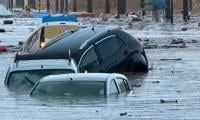A year back, former Pakistani Prime Minister Imran Khan while addressing the nation cautioned if the population of Pakistan kept on growing at the ongoing pace, the country might face hunger and poverty in the near future. This warning in the broader sense was explaining the relation between population growth and resource consumption. A rise or downturn in population influences the availability of resources for any population and determine the consequences it will face. One of the most populous country in the world, the Islamic Republic of Pakistan, is faced with the problem of an explosive population which, combined with the country’s inability to generate more resources, has created enormous insolvable problems for the country’s economy as well as for its people.
Water scarcity is a paramount issue and a stumbling block in the way of sustainable growth and development in the country. According to the World Bank, irrigated agriculture constitutes 20 per cent of the total agricultural land and plays a part in 40 per cent of the food produced globally. As the population rises, the demand for water resources also rises for greater agricultural yield. Between the years 1947 and 2021, Pakistan’s population proliferated from less than 40 million to 220 million presently. In the same period, the relative growth in water resources declined at an alarming rate. At the time of Pakistan’s independence in 1947, every Pakistani could use 5,600 cubic meters of water which were reduced to 5,260 cubic meters in 1951; 1200 cubic meters in 2007; 1100 cubic meters by 2009; 100 cubic meters in 2010 and went to the unprecedentedly lowest level of 908 cubic meters in the year 2007. This level is expected to fall below 800 cubic meters by 2025. The population of the country had been increasing exponentially throughout its history, but the country’s dwindling economy was unable to build more dams equivalent to its needs. The industrial and domestic wastewaters are drained into sewage without processing which, apart from being wasted also causes water pollution leading to the spread of a number of harmful diseases and diminishing life expectancy.
The share of agriculture in the Pakistani economy has reduced from 53 per cent in 1959 to approximately 19 per cent in the present time. The textile sector which contributes 60 per cent to the country’s exports, is facing a cotton shortage. Today, Pakistan is producing half of the cotton that it was producing a few years ago. This decrease in productivity is by virtue of farmers’ increasing inclination toward growing food items which, according to them, bring back handsome income as they are consumed by a huge population. Now, despite being the fifth largest producer of cotton in the world, the country imports cotton to fulfil its needs. The second agricultural product which has undergone shortages in the past few years is wheat. Despite being the seventh largest producer of the wheat, the wheat supply gap in Pakistan is looming day by day. The indigenous agricultural products in which Pakistan has been calling itself self-sufficient are unable to feed its own exponentially growing population.
The contribution of industry to the country’s economy is 21 per cent but it pays 70 per cent tax and provides livelihood to a greater proportion of the population. Nearly a decade ago when Pakistan was facing a huge energy crisis, the Pakistan’s textile industry was on its way to be relocated to Bangladesh where it was promised a comparatively better environment, with an adequate supply of electricity and gas, as reported by Reuters in 2011. This was a stumbling shock to Pakistan’s economy as the textile industry accounted for 38 per cent of the labour in the manufacturing sector and over half of its exports (25 billion dollars) had ceased to exist as part of it any longer. During this period (2011-2016), the unemployment level in the country rose from 0.8 per cent to 3.78 per cent. The decrease in purchasing power disincentivised people to spend on education which led to a resultant increase in rates of crimes and suicides. The street crimes made cities unsafe for living. This surge in insecurity made the country unfit for foreign investment. The exports also fell for buyers were feeling insecure to make deals to purchase materials from the country where their merchandise was insecure.
Apart from causing economic and social issues, population growth is also an admissible cause of pollution. According to the Air Quality Index, Lahore is amongst the most polluted cities in the world. A report by WaterAid Global says 21.7 million Pakistanis don’t have access to clean water. The population may be the very important factor behind the depletion and deterioration of resources but it is not the one and only factor. It is also the poor policy-making and policy-execution procedures. The population can itself be considered a vital resource as it is a human resource. Its qualitative aspects like literacy and life expectancy have a greater contribution to play in economic and social sectors of development. The United Nations’ demographic projections about Pakistan have revealed that the country’s population which currently is 220 million will reach an alarming number of 245 million by 2030.
For Pakistan to have a secure future, it has to devise and implement meticulously structured long-term policies to make sure generation, conservation, careful use, proper utilisation and recycling of resources. The availability of resources for people is crucial because resources sustain their lives.
-The writer is a student of Defense and Strategic Studies (DSS) at the Quaid-i-Azam University and a research intern at Islamabad Strategic Studies Institute















